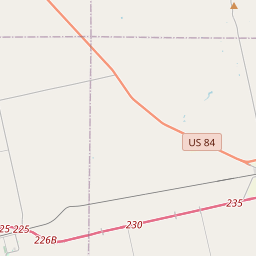W.A.S.P. (Women's Airforce Service Pilots) Training Base: Avenger Field
Historical marker location:






Site of World War II drama. Here girls, like male cadets, learned to fly United States Army Air Forces planes. WASPs had civil service status rather than military. Of the 25,000 applicants, 1,830 were accepted; 1,074 won wings and flew 60 million miles for the U.S. Army Air Forces, receiving high praise for their record. At the request of the Air Forces' Commanding General H.H. ("Hap") Arnold, Jacqueline Cochran became director of women pilots. On November 17, 1942, when the first 28 trainees entered the women's flying training detachment at Houston Municipal Airport, the program began. On February 21, 1943, it was relocated at Avenger Field, 3 miles west of Sweetwater.
The last class of WASP's graduated on December 7, 1944. British Royal Air Force cadets trained at Avenger Field June 22-August 1, 1942. U.S. Army Air Forces April of 1943. Arrival of WASP trainees made Avenger the only military coeducational flying field in United States history. WASP's came from varied backgrounds. Many were wives, sisters, or sweethearts of servicemen, hoping to hasten war's end. Women staff advisors supervised the nonflying activities of WASP trainees, who lived under military discipline: In army barracks. Trainees flew in "zoot suits" (ill-fitting GI coveralls), and had tan slacks and shirts for dress wear. After the santiago blue uniform was officially adopted, it was worn by graduates. Originally, the seven months course included 180 hours of ground school, 115 hours of flight training. From light planes, WASPs advanced to fly every air corps craft in use at the time. WASPs ferried planes; towed targets; flew tracking, smoke-laying, searchlight, strafing, and simulated bombing missions; did radio control flying, tested aircraft, gave instrument instruction; performed many other duties. Thirty-seven WASPs gave their lives serving their country. Ethel A. Sheehy was WASP staff field executive; Nancy Harkness Love, WASP staff executive-ferrying division; Leoti Clark Deaton, WASP staff executive-training bases. WASP wings, with diamond lozenge, signify women's pioneering wartime flight achievements.
(1972)
As one of the most visible programs of the Texas Historical Commission (THC), historical markers commemorate diverse topics in Texas history, including: the history and architecture of houses, commercial and public buildings, religious congregations, and military sites; events that changed the course of local and state history; and individuals who have made lasting contributions to the state, community organizations, and businesses.
Texas has been a major oil-producing state for over a century. The first big oil discovery in Texas was the Spindletop field near Beaumont in 1901, which set off a massive oil boom that transformed the state's economy and made Texas one of the wealthiest states in the country.
The first permanent Anglo-American settlers arrived in the 1870s, attracted by the fertile land and opportunities for ranching. The community of Sweetwater was established in 1879, named after the fresh water springs found in the area. The town quickly grew and became an important trading center for the surrounding agricultural and ranching communities.
In the late 19th century, the discovery of oil in nearby areas sparked an economic boom in Nolan County. Oil drilling and production became prevalent, attracting workers and boosting the local economy. This resulted in the development of additional towns and communities, such as Roscoe, that relied on the oil industry for growth and prosperity.
Throughout the 20th century, Nolan County continued to benefit from the oil industry, while also diversifying its economy. The agriculture sector remained important, with cotton farming and cattle ranching being the primary sources of income. Additionally, wind energy became a significant part of the region's economy in recent years, with numerous wind farms being established.
Today, Nolan County is known for its rich history, vibrant communities, and diverse economic activities, including agriculture, oil, and renewable energy. The county's heritage is celebrated through various cultural events and preservation efforts, ensuring that the history of Nolan County remains a significant part of its identity.
Nolan County Timeline
This timeline provides a condensed summary of the historical journey of Nolan County, Texas.
- 1858 - Nolan County is created and organized from Bexar County.
- 1879 - The first permanent settlement is established in the area by brothers Isaac and Lewis Newton from Illinois.
- 1880 - The town of Sweetwater is founded and becomes the first county seat.
- 1881 - Sweetwater wins the election to remain the county seat.
- 1890 - The Texas & Pacific Railway reaches Sweetwater, promoting growth and development in the area.
- 1911 - Roscoe is incorporated and becomes a major agricultural center.
- 1928 - Completion of Lake Sweetwater, providing a reliable water supply for the region.
- 1942-1945 - Nolan County contributes to the World War II effort through the establishment of airbases and military training facilities.
- 1950s - Sweetwater becomes known as the "Windmill City" due to the large number of windmills manufactured in the area.
- 1973 - The Nolan County Coliseum is built, becoming a popular venue for events and activities.
- 2004 - Sweetwater hosts the first annual Rattlesnake Roundup, attracting visitors from around the world.